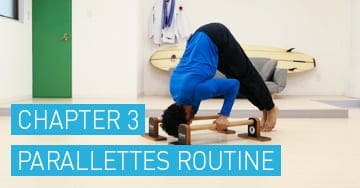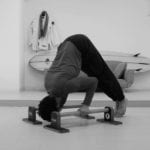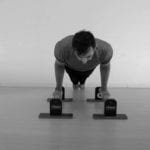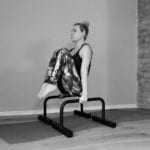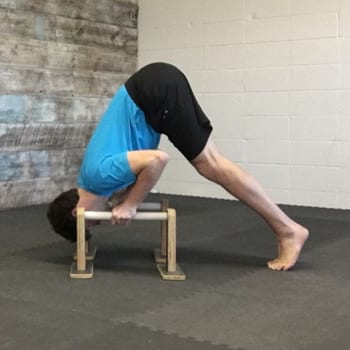 After working on the full parallettes routine we gave you in the last chapter of this guide, now you’re ready to kick things up a notch with your parallettes training.
After working on the full parallettes routine we gave you in the last chapter of this guide, now you’re ready to kick things up a notch with your parallettes training.
You’ve always wanted to learn cool skills like the inverted press and bent arm stand, so you want to dive deep into using the p-bars specifically for building up your bent arm pressing strength. And the p-bars are great for that!
In this chapter, we’ll talk about the benefits of building bent arm strength with parallettes vs. on the floor, and show you some fundamental skills (plus some fancier tricks) to help you out.
How Parallettes Will Help You Build Up Your Bent Arm Strength
 The parallettes are helpful in a few different ways when working on bent arm strength.
The parallettes are helpful in a few different ways when working on bent arm strength.
Perhaps the way that’s most obvious is they make your hands higher than your feet. This elevation changes the work load, and for movements like the push-up and inverted press, this decreases the amount of force your upper body has to generate to push you back up.
The leverage you gain from the parallettes allows you to focus on things like form and efficiency.
Also, the wrist position used on the parallettes makes it easier to feel supported through the shoulders. With the palms facing each other and in a fist position, this creates more distribution of load in the muscles that support the front and back of the shoulder girdle.
Ultimately, this gives you a chance to learn how the move should feel, so as you gain strength and move to variations off of the parallettes, you have a good sense of what it feels like to perform the movement “correctly.”
Parallettes Bent Arm Strength in Action
In this video, I’ll show you some common and popular bent arm pressing strength skills on the parallettes, and go over some key points for each.
Let’s look at these key points a little more closely.
Parallettes Push-Up
 Push-ups on the parallettes work on bent arm strength in the plank position, which not only develops your pecs, but ensures you can quickly get up off of the floor if you are lying on your stomach, connecting you to your inner ninja.
Push-ups on the parallettes work on bent arm strength in the plank position, which not only develops your pecs, but ensures you can quickly get up off of the floor if you are lying on your stomach, connecting you to your inner ninja.
There are some key points to remember while doing push-ups on the parallettes bars.
The first is to make sure your wrists are in a good position to support your weight. When you place your hands on the parallettes bars to set up for a push-up, your shoulders should be more or less over your hands. When you look down, your wrists should look straight. The knuckle of your thumb should be pretty much in line with your wrist.
The position of the hands means the elbows will move behind you, staying fairly close to your sides.
One way to figure out elbow placement is to keep your elbow “pits” (the non-pointy side) facing forward, with the pointy part of the elbow pointing behind you.
Another thing you want to focus on is keeping the torso straight so that when you lower your body down, you move as a unit. Your chest and hips will stay in the same line. If you are struggling with this, think about making your entire body as tight as you can. This will help you build the necessary core strength to move your body as a unit.
Establishing good mechanics now will make it much easier to transition to the floor later.
Triceps Dips on the Parallettes
 Dips are a great way to develop triceps strength both in the straight arm and the bent position. Like with the push-up, there are a few points to remember to make sure you are building efficient strength.
Dips are a great way to develop triceps strength both in the straight arm and the bent position. Like with the push-up, there are a few points to remember to make sure you are building efficient strength.
The set-up still consists of having the shoulders over the wrists, but your torso is in a very different position.
The tricky part with the set-up is if your hips are too far forward when your elbows bend, the motion doesn’t look much like a dip. It’s more like a strange reverse tabletop variation. So make sure your hips are back far enough that your torso is vertical (this helps with the L-sit set-up in the next chapter).
Also, just like the push-up, you want to make sure the wrists are straight. When you bend the elbows, the elbows should go straight back, creating the leverage and strength to lower your hips straight down to the ground. As you press through the hands to straighten the elbows, your hips will move back up to the starting position.
Remember, it’s a triceps dip, not a shoulder dip, so when you set-up, make sure your shoulders are away from your ears and your neck is long. As you perform the movement, the shoulders shouldn’t elevate or move forward.
This will allow you to create more work in the triceps, while strengthening the muscles that support the shoulder.
If you feel a lot of pressure in the hand between the thumb and the index finger, play with how you load your hands when you lower down. The elbows should move straight back, toward the wall behind you, not out to the sides. Often, making sure your elbows are going the right direction will change what you experience in your hands.
Inverted Press with Parallettes
 Loading your weight on to your hands with your elbows bent, like in a handstand push-up, can seem daunting. The inverted press on the parallettes not only develops strength and coordination, it will also give you the confidence to begin moving the weight of your torso over your hands.
Loading your weight on to your hands with your elbows bent, like in a handstand push-up, can seem daunting. The inverted press on the parallettes not only develops strength and coordination, it will also give you the confidence to begin moving the weight of your torso over your hands.
The set-up for the inverted press is similar to the push-up, except your hips go high so you are in an inverted V-position. The more you position your hips over your hands, the harder the movement becomes.
Just like with the push-up, make sure your hands are under your shoulders and your wrists are neutral. When you bend the elbows to lower down, the elbows should go straight back in the direction of the feet, not out to the sides. If you set up with the parallettes bars too wide, it won’t feel very smooth when you lower down.
One of the best ways to get into a solid starting position is to aim the top of your head towards the floor.
You will probably need to lift up your heels, which is perfectly fine. One of our shorter trainers uses the high parallettes bars, and she places her feet on a book when she’s doing these so she can get in a slightly better starting position. To maximize the effectiveness, pay attention to your set-up.
As you lower down, don’t let your wrists change position. This will require you to press the hands into the parallettes bars the entire time, which is good practice for bent arm skill work that’s done on the floor.
Maintaining the pressure on the hands not only gives you more strength, it will also make you feel safer in the movement.
If you have never done an inverted press before, make sure you don’t lower so far down that you can’t press yourself back up. Make the movement small in the beginning, and as you get used to what the position feels like, you can begin increasing your range of motion.
Don’t Forget About Building Straight Arm Strength
Developing bent arm strength on the parallettes bars translates into a wide variety of useful strength and gives you the confidence to load your upper body in a way that can be a little bit scary on the ground.
But don’t forget about straight arm strength too–it’s just as important for everyday life.
In the next chapter, we’ll show you how the parallettes will help you develop the straight arm pressing strength you need for everyday life, as well as building up to more advanced skills.
Want to go even further with your p-bar training? Check out our Parallettes One course.

